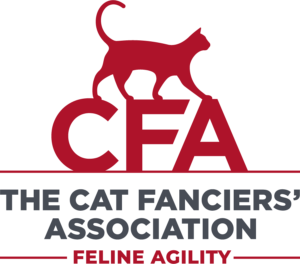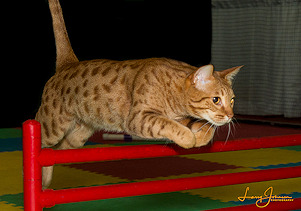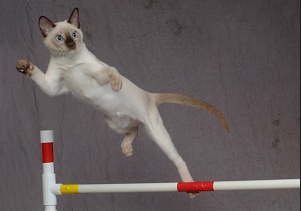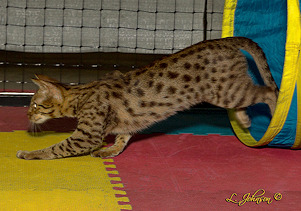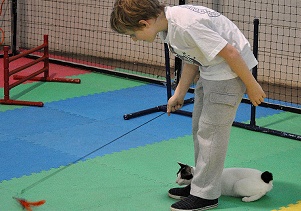Agility Training For Your Cat
Text: Chris and Linda Shaffer
Pay attention sports fans! There’s a new wind blowing through the cat show circuit! For the past several years, the dogs have commanded center stage in the agility arena, garnering virtually all of the exposure on the ever-popular Animal Planet cable channel. Now it looks as though the cats will be giving the dogs a run for the money – or, at least, the spotlight. Let me introduce you to the exciting world of cat agility.
While cat agility is very new, it’s gathering steam as it rolls through the CFA show circuit. My interest in agility started at the beginning of 2001. I have a black & white Maine Coon mix named Tennessee Tuxedo (older people will get the reference). I had Tennessee in a pet visitation program where we’d go to nursing homes and let people pet him for health improvement. He always did a good job letting people pet him and be with him until the year 2000. He was traumatized that summer by tree removal going on in the neighborhood. The workers brought in those big, industrial grade wood-chippers and the noise absolutely traumatized Tennessee. He hid for two solid weeks! When we finally got him calmed down, after the tree removal was done, he started attacking the nursing home residents.
I was pretty distraught at the thought of quitting the pet therapy program, so I looked around online and found an email list on Yahoo Groups for clicker training cats. I bought a clicker and got some beginning tips from the group and started training not only Tennessee, but all my cats. They all loved it! I’d already taught them a few tricks some years ago, just for fun and without a clicker, but now I was ready to really get into it. Tennessee proved to be the quickest by far at picking up on what I wanted him to do.
Getting Started with Clicker Training
 One of the foremost authorities in the clicker training world is Karen Pryor. Karen has recently written a book, titled Clicker Training for Cats. It’s a very good book to help you get started with clicker training. It explains all the basics and you can even get a whole clicker training packet, including the clicker, from her web site at www.clickertraining.com. You can also get a clicker at any of the major pet store outlets, such as PetSmart and Petco.
One of the foremost authorities in the clicker training world is Karen Pryor. Karen has recently written a book, titled Clicker Training for Cats. It’s a very good book to help you get started with clicker training. It explains all the basics and you can even get a whole clicker training packet, including the clicker, from her web site at www.clickertraining.com. You can also get a clicker at any of the major pet store outlets, such as PetSmart and Petco.
Since this article is focusing on using this training specifically for agility, I’ll skip over the basics and go right to agility training. However, if you’re just starting out, I strongly suggest you join the group at Yahoo and read Karen Pryor’s book. Agility is advanced training and you really should have the basics down first. Believe me though, your cats will love all the training you give them.
Current Cat Agility Theories
In the short existence of cat agility competition, I’ve seen three theories emerge. The first is the currently accepted method of “luring” to get a cat through the agility course in competition. A toy is used to lure the cat into “chasing” it through the course. This works better than many people would think. Throughout the weekend, cats try and try again. After several times running through the course, chasing a lure, the cat seems to realize that the real goal is to get through the course by negotiating the obstacles. It’s amazing to watch this because you can actually see the cat working it out in his mind! While this is terrific fun, there are a few disadvantages to this theory. I think the first one is that it doesn’t quite stand up to the quality of the competition that the dogs go through. The second is that it takes several times running the cat through the course before they get it – IF they get it.
Another theory that has popped up is the idea of “back-chaining.” In this theory, you teach a cat the agility course in reverse. You start with the last obstacle and train the cat on it, using the clicker, and then, once they get it, you move to the next previous obstacle and teach that one as well as the last one, and so on. This method is fine, and fun too, but it takes a long time and the cat will only know one course that’s set up one way.
The last theory is my theory. I think people have not given cats any credibility for being able to be trained to run through a course the same way dogs do. My Tennessee has proven that you can expect cats to know obstacles and respond to them by seeing the obstacle, hearing the voice command, and seeing the hand command (or any one of the three). I simply trained Tennessee on each obstacle (I’ll go over the obstacles a little later). Once he got an obstacle down, like a hurdle, I’d move on to the next. He understands each obstacle individually. You can move the course around any way you want and he will still jump the hurdles, goes over the A-frame, and through the tunnels just based on knowing the obstacle, hearing my command and seeing my hand signal (I think his knowledge of the obstacle itself is the biggest part of it though). I think people who have used the back-chaining method will probably find that their cat is actually not tied to the course layout and will negotiate each obstacle just like my Tennessee does. Try it!
I wish I could demonstrate, but, unfortunately, Tennessee, being a mixed breed and not a show cat, will only do agility in my house, and not in public. I tried putting him in a cat show years ago with disastrous results. He still attacks people when he gets away from home (needless to say we had to quit the pet visitation program anyway). I have, however, dazzled many a neighborhood child with my “cat circus.” This should not be a problem for experienced show people as your cats grow up with the shows and are quite relaxed and easily adapted to the crowds and noise.
The Agility Course
The basic course includes hurdles of different heights, an A-frame obstacle the cat climbs over, one or more tunnels, one or more hoop jumps, and some weave poles. You can go out on the internet and pay big bucks for “official” tournament-grade agility equipment. I, personally, don’t have that much money and have found much more economical ways of creating agility equipment.
One girl in the cat-clicker group, Judy, posted designs for hurdles using cardboard. I made a number of hurdles of different heights using this design and really like it. Most of my cats are more interested in rubbing their faces against them rather than jumping over them though.
For the A-frame, I’ve been using 2 of those Alpine scratchers (with the corrugated cardboard scratching material) that tilt up at an angle. If you push the high sides together, it creates a nice small A-frame for starting out. I’m not sure what I’ll do about getting a higher one. Some ideas include getting wood from Home Depot and making the stair-style A-frame myself. Another idea is to buy 2 portable stair steps that are now available for elderly animals from cat tree vendors.
The tunnel I’m currently working with was a long box that a canister vacuum came in. I reinforced the corners by gluing small pieces of cardboard to them so that it stands up really well. You can get some tunnels that hook together from the larger pet stores or you might see if children’s tunnels at a discount toy store would be less expensive. It’s best to have one short one that can lay straight and two others that you can connect together and make a tunnel that turns a corner.
Hoop Jump: I haven’t made anything for this but I’ve heard of others that have purchased PVC pipe from Home Depot and made something like this. I strongly recommend having or making one of these if you are serious about training your cat for agility competition. When I was getting my ringmaster certification at the Cotton States Cat Show in November, I noticed most of the cats avoided the hoop jumps more than any other obstacle. I don’t know if this is happening at all the other competitions, but just the one made me realize that practice is particularly called for here. You may be able to get some more ideas about construction these from the cat-clicker list.
Weave Poles: Some people have created these from more PVC pipe. I, personally, used the larger-sized wine bottles, just setting them all in a row.
Training on the Course
 Hurdles: It’s a good idea to have hurdles of several different heights. For one thing, that’s what the cats will encounter in competition, but it’s also great to have a really low one to start out with. I use the target stick for this at first. Have the cat on one side of the hurdle and hold the target stick on the other side. Have the cat touch it once or twice for a click and treat, then hold it further away so that the cat must step over the hurdle to get to it. As soon as the first paw hits the other side, say, “Jump,” and click and treat.
Hurdles: It’s a good idea to have hurdles of several different heights. For one thing, that’s what the cats will encounter in competition, but it’s also great to have a really low one to start out with. I use the target stick for this at first. Have the cat on one side of the hurdle and hold the target stick on the other side. Have the cat touch it once or twice for a click and treat, then hold it further away so that the cat must step over the hurdle to get to it. As soon as the first paw hits the other side, say, “Jump,” and click and treat.
Keep practicing this until the cat really has it down. Make sure you train the cat to go over the hurdle from both sides. Otherwise you’ll have a cat that will only go over the hurdle one way. When the cat seems to understand that the expectation is to jump, you can drop the target stick and use a hand signal with the verbal signal to get the cat to jump (I swing my hand upward in an arc). With such a low hurdle, the cat will probably still just be walking over it, but that’s okay because he’s getting everything else down. Once the cat understands with just the verbal and hand signal, start moving to higher hurdles and the jumping will start.
 Hoop Jump: After the cat gets the straight hurdles down, you can graduate to the hoop jumps. This is not something I’ve taught my cat, Tennessee , to do so I’m going on pure knowledge, and some conjecture, here and not actual experience. The same training steps should work here as with the straight hurdles. Also, I would use the same verbal command, “Jump,” and the same hand signal. Be ready to spend some real time at first though if your cat is skittish about these. One of the neighbor kids gave me her hoola hoops when she outgrew them. I use those to get Tennessee to jump through, but as yet, they are not stationary; I have to hold them up. That might be an idea to start with as that’s a much bigger hoop. You can use PVC pipe to gradually get down to a smaller hoop. In any case, it may take quite a bit of patience and convincing in the beginning. If your cat gets this down, it’s quite an accomplishment.
Hoop Jump: After the cat gets the straight hurdles down, you can graduate to the hoop jumps. This is not something I’ve taught my cat, Tennessee , to do so I’m going on pure knowledge, and some conjecture, here and not actual experience. The same training steps should work here as with the straight hurdles. Also, I would use the same verbal command, “Jump,” and the same hand signal. Be ready to spend some real time at first though if your cat is skittish about these. One of the neighbor kids gave me her hoola hoops when she outgrew them. I use those to get Tennessee to jump through, but as yet, they are not stationary; I have to hold them up. That might be an idea to start with as that’s a much bigger hoop. You can use PVC pipe to gradually get down to a smaller hoop. In any case, it may take quite a bit of patience and convincing in the beginning. If your cat gets this down, it’s quite an accomplishment.
A-frame: This one is really easy. I use the target stick to lure the cat over it. It’s that simple. The big thing you have to watch out for is stepping over the side. Make sure they keep their feet on the obstacle. If you can get bigger and bigger things for them to climb over, that would be great. Small children’s chairs, set back-to-back, come to mind as a possibility before making the staircase used in competition. My verbal command here is, “over,” and my hand signal is a much larger arc motion.
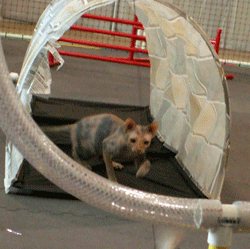 Tunnels: Tunnels are actually easier to teach than one would think. I started out using the target stick again. I’d get the point just inside the tunnel and get the cat to touch it for a click and treat. Then I’d get to the other end as fast as possible, and point the stick at him, motioning him to come. When the cat comes down to the end and touches the stick, click and treat again, saying, “through.” The cat will probably get this whole obstacle down pretty quickly. My hand signal is to just push my hand forward. This is another obstacle that needs to be trained from both sides.
Tunnels: Tunnels are actually easier to teach than one would think. I started out using the target stick again. I’d get the point just inside the tunnel and get the cat to touch it for a click and treat. Then I’d get to the other end as fast as possible, and point the stick at him, motioning him to come. When the cat comes down to the end and touches the stick, click and treat again, saying, “through.” The cat will probably get this whole obstacle down pretty quickly. My hand signal is to just push my hand forward. This is another obstacle that needs to be trained from both sides.
Weave Poles: This is another obstacle where luring plays an important part in the beginning. The command I use is, “weave, weave, weave.” With that, I snake my hand in a weaving manner. Start with just 2 poles. Again, get the cat to go through from either end. You’ll probably graduate quickly to 3 poles, but don’t be disappointed if it takes quite a while and some effort for the cat to get beyond 3 poles. Have patience and occasionally go back to something the cat knows easily just to give him some needed confidence.
While weave poles are currently used in all cat agility competitions, it should be noted that these are only used in the most advanced of the dog competitions. It is my hope that, when cat agility really catches on, we’ll have enough competition to start dividing up into beginner and advanced courses. For right now though, it’s a great idea to start teaching the more eager cats to do the weave poles. We may just have to stick to luring through the weave poles in competition for awhile.
If you’re interested in learning more about clicker training for your cat, even if not for agility, I strongly suggest you begin by reading Karen Pryor’s web site. If you’re REALLY serious about clicker training, you might also want to check out the programs for becoming a certified training at this same web site.
